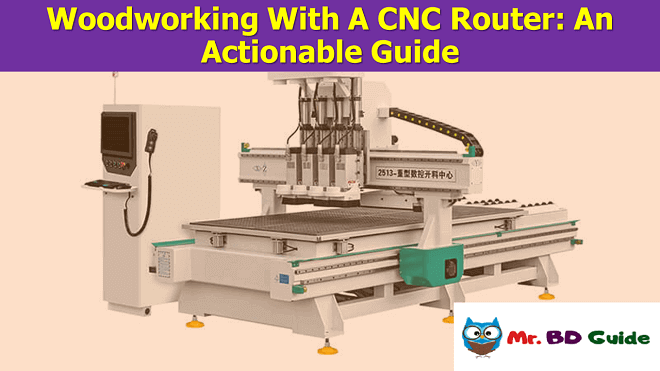Woodworking With A CNC Router: An Actionable Guide


Regardless of whether you are a full-time carpenter or merely a casual enthusiast, the chances are acceptable that you’ve heard of woodworking with a CNC router.
You may have even utilized a small handheld router in the workshop, carving out a cabinet entryway pattern or steering out openings for locks and pivots.
Whatever your experience level, this guide is here to give you all the information you have to make you more familiar with one of the most versatile woodworking apparatuses available today.
What is a Woodworking Router: The Definition
The first English word, “to defeat,” literally means to carve out or gouge out. Routers are all about making openings, uncovering or penetrating material, and leaving an unfilled space behind.
Routers have for some time been a favorite of furniture and cabinet makers, mainly craftsmen who use joinery – fastening at least two bits of wood together without utilizing screws.
Regularly that was finished by creating interlocking patterns on the two bits of wood or utilizing dowels or wooden bars to associate them.
In the two cases, routers were utilized to create openings or openings.
The primary controlled routers were handheld models, and you can, in any case, discover them broadly available today.
While considerably less ground-breaking than the CNC router, carpenters depend on the handheld models for a large part of the everyday steering and cutting fundamental in woodshops.
Handheld routers appear to be somewhat unique from most different devices you’ll discover in a workshop.
Most routers comprise two handles on one or the other side of a flat plane.
Projecting down from the focal point of the plane is a solitary cutting piece or apparatus.
The rotation of that spot is always perpendicular to the flat plane, allowing an artisan to cut straight, even openings in the workpiece.
Routers are regularly ordinarily utilized for edge work, adjusting sharp corners and creating a more decorative completion.
How Does a CNC Router Work: The Best Method
CNC routers operate on the same general standards as handheld routers, with the workpiece mounted on a plane and the cutting apparatus suspended above it.
With free development along the X, Y, and Z-axis, the router can cut into the workpiece at clear focuses.
Those focuses are controlled by the PC Numerical Control (CNC) program on your CNC router.
CNC utilizes those X, Y, and Z-axis to create a Cartesian coordinate framework; the guidelines the operator gives the router are based on that framework.
Those guidelines are typically communicated in G-code, the machine language utilized in virtually all CNC gadgets.
G-code issues command based on the coordinate framework; the mainline of code in a CNC program may advise the router where to move the instrument when to turn on, how far to bring down the drill, and how rapidly the router should move.
Regularly, the CNC program’s primary command starts with a “G” prefix; G20 or G21 trains the machine to utilize the English or metric measurement framework; G01 advises the machine to move the tool head in a line.
That propensity in the first place “G” eventually gave the CNC programming language its necessary name – g-code.
CNC allows routers to be far more exact and accurate than something else.
Once created, each program can be run on as many occasions as required and produce identical outcomes.
Woodworking With A CNC Route: Capabilities
Other than the accuracy, the tremendous appeal of a CNC router is the fact that each program can be repeated.
In the event that you are utilizing a router to create a raised bloom theme on a bunch of cabinet entryways, each entryway can be made absolutely identical.
Even better, the main part of the cycle requires the operator to be available in the programming and the physical loading of the workpiece.
The programming just should be done once, meaning that a whole arrangement of workpieces can be cut with minimal direct human mediation.
What Can Be Made With a CNC Router? Here’s a shortlist:
Make Signs With a CNC Router
“Joe’s Ancient Antiques” – the bygone wooden sign was hanging above the antique store entryway. Maybe it is an old sign – or perhaps it’s a cutting edge, CNC-carved shingle intended to look old.
Make Engraved Plaques With a CNC Router
CNC routers can cut metal, although it regularly requires unique pieces and careful strategies. You can utilize a CNC router to engrave names and dates on plaques or remove the engraved plate itself carefully.
Make Furniture With a CNC Router
For what reason do furniture manufacturers use CNC routers? Each part can be precisely the same, and each pre-sliced opening and space manufactured to correctly the same profundity. Not any more stressing over lopsided table legs or misshapen corners; CNC routers make the whole cycle more uniform.
Make Cabinets With a CNC Router
The same advantages apply to cabinetry, with the added advantage of all the decorative components routers can incorporate. Ornate cabinet entryways, carved insets can be programmed on a CNC router, conveying an ageless, hand-carved gander at a fraction of the time and cost.
Make Molds/Forms With a CNC Router
Utilize a CNC router to create exact wooden structures for an alternate venture entirely; designs for your woodstrip canoe, or create many sawhorses at correctly the same tallness. You can also utilize a CNC router with more unusual materials, similar to foam, to create molds for epoxy sap or plaster – anything that should be poured and then set.
Finishing Quote: Learn to Use a Router
The most ideal way to learn any CNC machine is to practice on one. Search for entry-level positions, join specialist clubs and Facebook gatherings, or even apply for occupation at a machine shop or woodworking shop.
Barring that, you can locate various assets on the web; YouTube instructional recordings for individuals leaning toward a self-educated approach or undeniable “Introduction to CNC” course available from various online academies.
CNC routers are broadly viewed as one of the most versatile of the woodworking devices.
They can be utilized to segment large, flat panels that maybe some way or another, be hard to maneuver, or be exclusively used to apply the final details to exceptionally decorative panels.
In the two cases, the whole cycle is streamlined and made far more accurate through CNC innovation.
We hope you have read about woodworking with a CNC Router and how you use it correctly to maintain its longevity.

![What Is The Best Strategy For E-commerce SEO [Definite Guide] 5 Best Strategy For E-commerce SEO](https://mrbdguide.com/wp-content/uploads/2021/11/61837b889bdf0-390x220.jpg)

